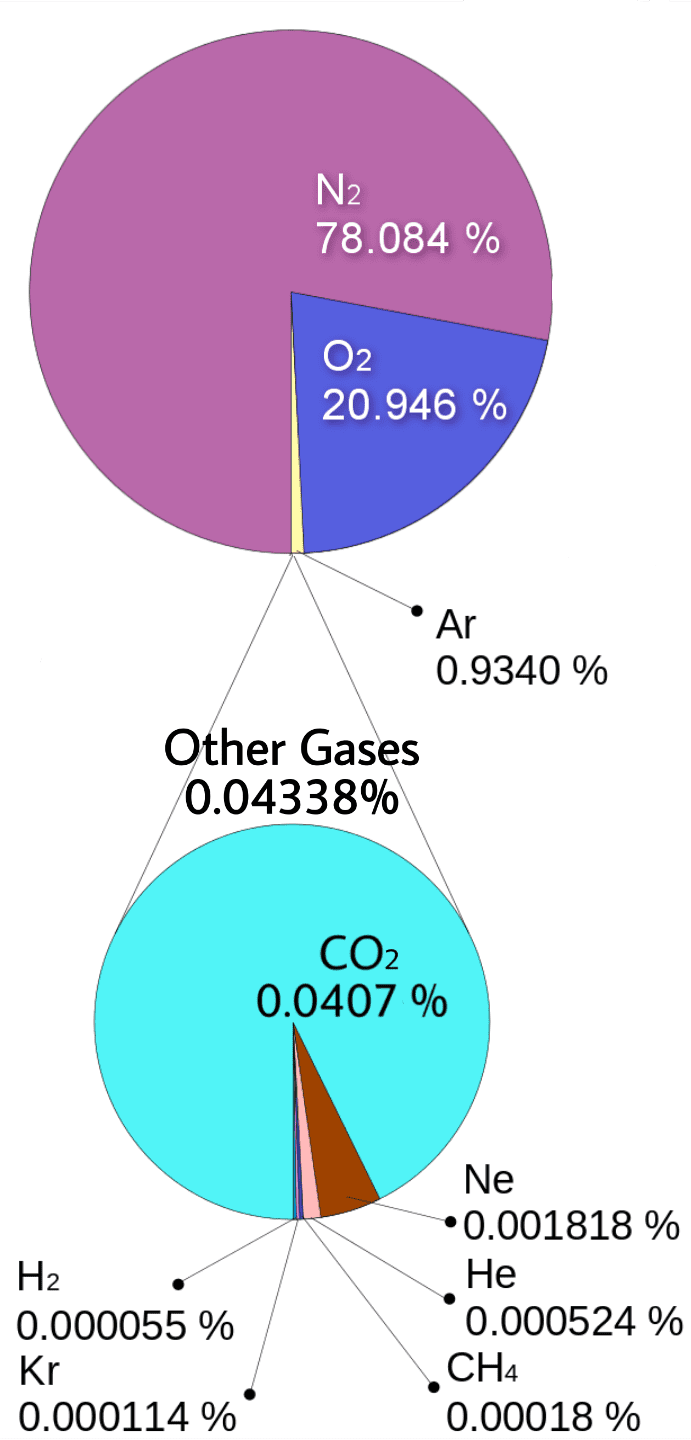Most Abundant Gas On Earth
Errah is a bookwormy and logophilic author and scientific discipline & technology teacher. He frequently writes about scientific ideas, theories, and inquiry.

The blueish heaven and the clouds that you see in a higher place are part of the atmosphere.
Photo past Author
The atmosphere is the layer of gases surrounding our planet. It is held past the gravity of the World, then it does not escape into outer space. Its function is to absorb the harmful rays of the lord's day. It also protects united states from meteor impacts and other celestial debris that fall on our planet. It is also the crusade of the conditions.
The temper is composed of different gases in unlike amounts. Its most abundant gases are nitrogen and oxygen which comprise 99% of the air. It follows by almost i percent business relationship for argon and a very tiny amount of pollutants, greenhouse gases, and other gases.
The acme x nearly arable gases in the temper are shown in the table and pie chart below.
Top 10 Nearly Abundant Gases of the Atmosphere, by Book Percent
| Name of Gas | Formula | Volume Percent |
|---|---|---|
| Nitrogen | N2 | 78.084 % |
| Oxygen | O2 | 20.946 % |
| Water | Water | 0-3 % |
| Argon | Ar | 0.9340 % |
| Carbon dioxide | CO2 | 0.040700 % |
| Neon | Ne | 0.001818 % |
| Helium | He | 0.000524 % |
| Methane | CH4 | 0.00018 % |
| Krypton | Kr | 0.000114 % |
| Hydrogen | H2 | 0.000055 % |
Volume Percent of Master Elective of the Dry Air

This pie graph shows the volume pct of the dry atmosphere. H2o is excluded because its amount may vary.
What are the characteristics of these 10 gases? Let's find out below.
1. Nitrogen
Nitrogen (N2), as well chosen azote, is the most abundant gas in our atmosphere. Information technology is an inert, diatomic compound. Its name comes from the Greek words "nitron" which ways "native soda" and "genes" for "producer." It is used to make fertilizers, nylon, nitric acrid, ammonia, and explosives. Moreover, the air that half-empty your murphy chip bag is actually nitrogen. It prevents the chips from oxidizing, which makes them go stale.
Nitrogen is essential to life and its compound nitrate (NOiii) is needed to construct Deoxyribonucleic acid, RNA, and amino acids. It is converted to nitrate through lightning storms and nitrogen-fixing leaner. The bacteria capture atmospheric nitrogen to convert it to ammonia (NH3). The ammonia catalyzes biological oxidation and becomes nitrite (NO2) and nitrite undergoes another oxidation and becomes nitrate. Nitrate nourishes the soil and is absorbed by the plants. The plants catechumen it to amino acids. The animals cannot create their amino acids, then they eat the plants to gain the nutrients. When the organisms died, they decompose past bacteria and release ammonia and nitrogen back to the atmosphere. The nitrogen will capture over again by bacteria and the process repeats.
Nitrate is also formed when lightning struck the diatomic nitrogen. The two atoms of nitrogen separate and speedily combine with oxygen. Then, they bail with the h2o molecule in the cloud forming the nitrate. The nitrate will autumn together with the rain, nourish the soil, and be absorbed by the plants.
two. Oxygen
Oxygen (O2) is a very reactive, diatomic gas. Information technology easily combines with another element and is incorporated with many chemical compounds such as h2o (H2O) carbon dioxide (CO2). It is the cause of combustion. When the oxygen combines with the other molecule in the air, it results in burning.
Oxygen is released past innumerable plants, green algae, and cyanobacteria every bit a waste material production of photosynthesis. It is needed and breathed past humans, animals, fungi, and other eukaryotic organisms to survive.
It tin can also form into three molecules of atoms, which is known as the ozone. The ozone layer is located in a higher place the clouds. It helps united states of america to block the harmful ultraviolet radiation from the sun.
3. Water Vapor
The amount of water (HiiO) in the temper may vary depending on the conditions condition and location on the earth, and it is not always in the gaseous grade — it can exist also in the form of solid (such as water ice and glaciers) and liquid class (such every bit ocean and river) naturally. In the tropical region, where the climate is warm, the water evaporates, so the humidity is high. In extremely cold areas, such equally Antarctica, where the water freezes, and in the barren region such equally the Sahara desert, water vapor in the air may exist absent-minded.
Most of the water is full-bodied in the lower atmosphere. Information technology is one of the 4 factors that influence the atmospheric condition — the other factors are wind, temperature, and pressure. During the hot day, water on the surface of the earth is heated and evaporated becoming function of the atmosphere. Once the air is cooled to its dew point, it condenses to form clouds and precipitates dorsum to earth in the grade of rain and snowfall. H2o tin can be as well in the form of fog, drizzle, hail, frost, and dew.
Water vapor is an constructive greenhouse gas and can contribute to global warming. Fortunately, it does not stay in the air for a long time, so we don't worry about it. It condenses and back to earth naturally, unlike carbon dioxide and methane that last for decades.
Water covers effectually seventy% of the Earth's surface. Information technology is essential for life on Earth. Apart from drinking, people have many uses for it such every bit bathing, irrigation, cooking, washing, etc.
Curl to Go on
iv. Argon
Argon (Ar) is a colorless, odorless, inert, nonreactive, noble gas. It comes from the Greek discussion "argos" which ways "non working" or "lazy" due to its disability to combine with another element. Information technology is the third near abundant gas in the dry atmosphere, at about one percent. All the same, information technology has no known environmental role. But in industry, it is used for the welding and the production of titanium.
5. Carbon Dioxide
Carbon dioxide (CO2) is an acidic, inert, inflammable chemical compound. It is the bubbles that you run into in soda, beer, and vino. It is formed during fermentation, decaying organic waste and organisms, volcanic eruption, and burning organic material and fossil fuel. Furthermore, information technology is released by humans, animals, fungi, and other eukaryotic organisms.
Carbon dioxide is a very important greenhouse gas. Information technology absorbs many infrared wavelengths of the lord's day'due south lite that gives heat to our planet. Too much greenhouse gas can cause global warming. Global warming can cause climate change, which is a serious threat to life on globe through farthermost atmospheric condition, and widespread flooding. And sadly, carbon dioxide lasts for many centuries in the air.
half-dozen. Neon
Like argon and other noble gases, neon does not react or combine with other elements. Neon is an inert, monatomic gas and is about 2-thirds of the density of air. It is a colorless substance but exhibits a reddish-orange glow in vacuum tubes. It is unremarkably used in ad signage, television tubes, lightning arrestors, and lasers.
seven. Helium
Helium is named after the Greek god of the sun, Helios. It relates to the fact that it was discovered on the sun's corona and was believed to exist only in the sunday before it was found on world. This noble gas is odorless, colorless, and nonreactive. Information technology has the everyman melting point (-272.2 °C) and boiling point (-268.ix °C) of the element.
Nearly of them are concentrated in the upper temper considering this gas is very light, so, it floats in the sky. This is the reason why nosotros used it for filling balloons and airships. It is the 2nd most arable element in the universe, withal, it is rare on earth. Because of its lightness, gravity is not strong enough to concord on to it, so, it tin escape into outer space.
viii. Marsh gas
Methyl hydride (CH4), also called marsh gas, is an odorless, flammable chemical compound. Methane is released by decaying organic waste and expressionless organisms, digestion of termites, and ruminants (animals with 4-chambered stomachs such as cows, deer, sheep, and giraffes), and emits by volcanoes and vents in the ocean floor. It is the principal component of natural gas or the fossil fuel that nosotros used for cooking and provides ability to our motor vehicles.
Methane is the leading contributor to the greenhouse result and global warming. Information technology is a very unsafe gas and is 86 times more powerful than carbon dioxide. Fortunately, information technology can simply concluding for 10 to 12 years, unlike CO2 that lasts for centuries.
9. Krypton
Krypton (Kr) is produced past the fission of radioactive uranium. The concentration of Krypton at the North Pole is 30% higher than at the South Pole due to virtually all the world's nuclear reactors and plants are located in the Northern Hemisphere.
Krypton is a colorless gas but glows purple at a high temperature and emits a very bright white light when inside an electric field. The white calorie-free that is released by flash photography and calorie-free bulbs are produced past krypton.
ten. Hydrogen
The word hydrogen (H2) is from the Greek "hydro" ways "water" and genes for "forming" considering information technology is 1 of the parts that make up a water molecule. It is the lightest chemical chemical element in the periodic table so, similar helium, information technology floats in the air and escapes into space. Withal, it does not use for filling balloons because it is combustible and tin can explode.
It is the most abundant element in the whole universe only rare in the earth's atmosphere. Most of them are bounded to many chemical compounds such as water and hydrocarbons. Its compounds are used in many industrial sectors, including drinking glass, electronics, and metallurgy.
Sources:
- Atmosphere of World - Wikipedia
- Greenhouse Gas - Wikipedia
- Water Cycle | National Geographic Society
- nitrogen bike | Definition & Steps | Britannica
- Noble gas | Definition, Elements, Properties, Characteristics, & Facts | Britannica
This content is authentic and true to the best of the writer's knowledge and is not meant to substitute for formal and individualized communication from a qualified professional person.
© 2021 Errah Caunca
Misbah Sheikh from — This Beingness Is Only an Illusion on March 01, 2021:
Thanks for sharing this informative commodity, Eric
Perchance it will assistance me when I requite tuition class to my younger Brother
He is studying about Gases recently
blessings
Most Abundant Gas On Earth,
Source: https://discover.hubpages.com/education/Most-Abundant-Gases-in-the-Atmosphere
Posted by: ablerithey.blogspot.com


0 Response to "Most Abundant Gas On Earth"
Post a Comment